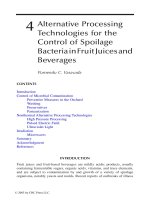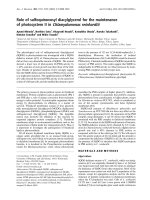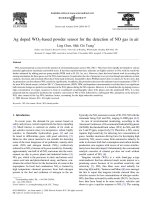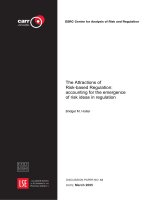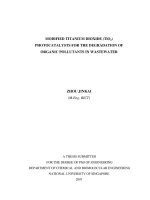possibilities for the creation of beer routes in hungary a methodological and practical perspective
Bạn đang xem bản rút gọn của tài liệu. Xem và tải ngay bản đầy đủ của tài liệu tại đây (1.07 MB, 13 trang )
Europ. Countrys. · 3 · 2016 · p. 250-262
DOI: 10.1515/euco-2016-0018
European Countryside
MENDELU
POSSIBILITIES FOR THE CREATION
OF BEER ROUTES IN HUNGARY:
A METHODOLOGICAL AND PRACTICAL
PERSPECTIVE
János Csapó1, Viktor Wetzl2
Dr. habil János Csapó, PhD., Associate Professor, University of Pécs, Faculty of Sciences, Institute of Geography,
Department of Tourism, Hungary, 7624 Pécs, Ifjúság. ú. 6.,
2 Viktor Wetzl, PhD student, University of Pécs, Faculty of Sciences, Doctoral School of Earth Sciences, Hungary,
7624 Pécs, Ifjúság. ú. 6.,
1
250/321
Unauthenticated
Download Date | 2/13/17 10:42 PM
Received 30 May 2016; Accepted 7 September 2016
Abstract: This study aims to analyse the possibilities and the potential for the establishment of
beer tourism, one of the most recently valorised tourism products of global gastro
tourism, and more importantly the creation and professional criteria of beer routes in
Hungary. With a thorough investigation of the theoretical background of beer tourism
and beer trails the authors try to collect those spatial perspectives which confirm our
idea that Hungary is possessing adequate resources for the initiation of this new
tourism product. We experienced that this area of tourism geography has not yet been
researched thoroughly in the country, for which we make an attempt in this paper,
using geographical and GIS methods, basically relying on the beer routes of Bavaria,
Germany as good practices.
Keywords: beer tourism, beer route, craft beer, thematic routes, experience brewery, Hungary,
countryside
Absztrakt: A tanulmány fő célja a sörturizmus, a globális gasztroturizmus egy viszonylag új és
egyre inkább erősödő szegmensének és potenciáljának a felmérése és bevezetési
esélyeinek fưldrajzi alapokon nyugvó ismertetése Magyarországon. Előzetes
tanulmányaink alapján kijelenthetjük, hogy a magyar turizmusföldrajz még csak igen
kevéssé foglakozott a területtel, így, ismerve a sưrfogyasztási és sưrtermelési
szokásokat és azok legújabb trendjeit, véleményünk szerint érdemes a témát
alaposan lekutatni. A sörturizmus és sörutak elméleti-szakirodalmi feldolgozásán túl
a cikk tehát Magyarország esélyeit elemzi ezen új turisztikai termék bevezetése
kapcsán klasszikus földrajzi és GIS alapokon nyugvó módszerek alkalmazásával.
1. Introduction, aims and objectives
In modern tourism an increasing interest can be experienced worldwide for the local products and
the locavore movement together with the growing popularity of such thematic routes which
represent the local values of gastronomy (Telfer, Wall, 1996; Cohen, Avieli, 2004; Jónás-Berki,
Csapó, 2008; Aubert et al., 2010; Karim, Chi, 2010; Kim, Goh, Yuan, 2010; Szabó, 2013; Williams
et al., 2014). Taking into consideration the international best practices, the first wine route of
Hungary has been established in 1994 (Villány-Siklós wine route) after which several others have
also been implemented (Tokaj-Hegyalja Borút, Mohács-Bóly Fehérborút etc.), parallel with such
thematic gastro routes (The Route of the Plum Pálinka of Békés County) which are based on
the supply of the pálinka, a special Hungarian alcoholic beverage under Protected Designation of
Origin (Csizmadia, Erdősi, Szabó, 2012; Szabó, 2013; Forman, 2009).
The primary assumption of this paper is that Hungary possesses cultural, industrial and natural
heritage for tourism development not only in the form of the upper mentioned local gastro products
but concerning beer manufacturing as well. This statement is based on the one hand on the
centuries-long tradition of the Hungarian beer manufacturing (Dreher Brewery from 1854, Pécs
Brewery from 1848) and on the other hand on the international trends of gastro tourism, namely
the repositioning and revaluing of the beer, since the consuming of craft beers and local beers is
getting more and more popular in the 21st century (Plummer et al. 2005; Bujdosó, Szűcs, 2012a,
2012b; Kraftchick, et al. 2014; Dunn, Wickham, 2016).
Due to the upper mentioned, this research is strongly relying on spatial aspects and geographical
research methods since it analyses the possibilities for the creation of a new tourism product,
the beer route as gastronomy based thematic route in Hungary based on the good practices of
the most well-known international examples. We would like to highlight that, nevertheless there
is an existing supply, this tourism product is not yet evaluated and researched in Hungary and is
not involved in traditional tourism product development plans and programmes. Our researches
are also based on the results of our different primary sources since we carried out a questionnaire
survey in order to understand the motivations of the possible beer tourists in Hungary.
251/321
Unauthenticated
Download Date | 2/13/17 10:42 PM
Based on the upper mentioned we set up numerous aims and objectives with this research. For
the first step we intended to create a national (small-scale) brewery survey. Than we aimed to
determine the spatial peculiarities of the Hungarian small-scale beer manufacturing and
the interpretation of its basic geographical patterns. After this procedure we planned to survey
the (possible) relation system among the small-scale and the multinational beer producers and to
elaborate the connections between the small-scale breweries and the qualified beer houses. For
the final step, based on the results of the earlier objectives, we intended to appoint certain
geographical spaces where there is the possibility for the creation of thematic beer routes in
Hungary.
2. Literature review
We can distinguish two major directions in gastronomy related to beer: the first is called “cuisine
à la bière” when you cook with the beer, and the second is when beer appears in gastronomy as
a type of alcoholic drink (only as a drink or along with a dish). As Plummer, R. et al (2005) states
“food and beverage tourism is increasingly being recognised as an important part of the cultural
tourism market.” (Plummer et al. 2005, p. 447) We also have to stress that gastro tourism is
an excellent example for tourists seeking authentic and unique experiences connected to local
foods and drinks, local cuisine and also the host culture of the visited area (Alonso, 2011, Cohen,
Avieli, 2004, Kraftchick et al. 2014). Therefore usually the countryside or the rural areas of
a country are highlighted in this respect. Another important demand from the (gastro) tourists is
that they hope to “immerse themselves in the culture they are visiting through authentic and
engaging experiences with people, cuisine, wine and other cultural activities” (MacDonald,
Deneault, 2001, p. 13).
The involvement of beer in tourism and the creation of thematic beer routes has several decadeslong traditions in the important beer manufacturing countries such as Germany, the Czech
Republic, Belgium or the USA, but in Hungary in the thematic system of tourism we can find no
such researches or existing tourism products (Maier, 1994; Foley, 2009; Alonso, 2011; Dunn,
Wickham, 2016; Kraftchick et al. 2014; Plummer et al. 2005). That is why the theoretical
background of this work was based mainly on international literature.
Concerning the Hungarian sources a great number of experts dealt with thematic routes in tourism
in general (Puczkó, Rátz, 2011; Jónás-Berki et al. 2008; Aubert, 2007; Dávid et al. 2011; Máté,
2007; Máté, 2011b). Based on the country’s agricultural traditions it is not surprising that from
the middle of the 1990s thematic tourism routes were created on wine and another alcoholic
beverage, the ‘pálinka’ (Hanusz, 2008; Máté, 2011b; Máté, Szabó, 2012; Várhelyi, 2012; Forman,
2009).
During the literature review of gastrotourism we realised that beer tourism – just unlike the other
gastrotourism products – can appear not only in the rural areas but in urban environment as well
(Gross, 2011; Richards, 2003), however, its presence is more dominant in the countryside.
A great number of researchers dealt directly with beer routes and beer tours within the research
of the thematic tourism supply (Freyer, 2006; Steinecke, 2007; Richards, 2003). It is also worth
mentioning that the German researchers classified the beer routes to a separate category (to
culinary culture) which covers not only gastronomy and cultural scope but a more complex
approach (Sven, 2011).
In the literature background we also shortly intend to highlight the recent trends in gastronomic
tourism with a special emphasis on beer. Again, the trend of using beer in gastronomy is rather
realised in Western Europe or North America, however, newer and newer forums and blogs
appear in Hungary as well promoting the extensive role of beer in gastronomy3.
3
( /> />
252/321
Unauthenticated
Download Date | 2/13/17 10:42 PM
3. Methodology
During the research the authors used both primary and secondary methods. Concerning
the literature review it has become clear very quickly that the Hungarian academic tourism experts
have only very limitedly dealt with the topic of beer tourism (Bujdosó, Szűcs, 2012a,b). Of course
domestic literature sources were much more available concerning publications on thematic or
cultural routes, or gastro tourism (Máté, 2007, 2011; Aubert et al. 2010; Dávid et al. 2011; Szabó,
2013).
One of the pillars of the primary researches was based on the establishment of the adequate
databases, so we surveyed on the national level the existence and spatial allocation of the smallscale breweries. The survey was carried out by electronic and phone call search, and we intended
to visit personally as much locations as it was possible. Here we have to mention that the lack of
the answering propensity made this survey very hard to achieve and it is also hard to tell the exact
number of small breweries in Hungary because of the recent and continuous fusions and changes
in the company names. However, we believe that we could create a reliable database on
the number and spatial allocation of the researched breweries.
The second pillar of the primary research was provided by the interviews and deep interviews
which were carried out from the beginning of 2014 and finished in 2015. We made personal
contacts with managers of craft breweries and we also carried out interviews with catering
managers selling craft beers at beer houses. The topics of the interviews with the mentioned
professionals covered areas such as the definition, the making procedure and the consumer
habits based on the craft beers, possibilities for the appearance of beer in tourism,
the opportunities for the creation of thematic beer routes in Hungary and the possible methods
for attaching beer and beer routes to the complex system of tourism.
As the first result of the primary research we identified 46 small-scale breweries in Hungary. After
this we elaborated the Hungarian consuming demand connected to beer consumption. Based on
this we would like to highlight that, nevertheless Hungary is not possessing as rich, old and
reputed beer culture as Germany, Belgium or the Czech Republic, on the one hand the country’s
beer manufacturing history is also several centuries old and on the other hand the beer consuming
trends and habits project the revival of craft and quality beer manufacturing in the country parallel
with a growing tendency of quality beer consumption (Figure 1).
The growing
demand for
craft beers,
looking for
special
gastronomy
values
The increasing
appearance of
gastro events
connected to
craft beers
Education:
brewer
trainings, beer
sommelier
trainings
The
appearance
and
strengthening
of qualified
craft beer
houses
Both the
demand and
the supply of
beer tourism is
continuously
growing
Fig 1. Factors contributing to the appearance of beer tourism in Hungary. Source: Csapó – Wetzl, 2016.
253/321
Unauthenticated
Download Date | 2/13/17 10:42 PM
This was also based by our questionnaire survey where we surveyed the consumption patterns
of the Hungarian population. During this non representative questionnaire we received
information from altogether 500 respondents. Here, at the demand survey, we (of course)
questioned more than 18 years old adults.
The data of the international demand trends were provided by the databases of the statista.de
and the Wine Institute of California. Here we have to add that these data consist only the amounts
of beer consumption based on the commercial turnover of the multi beers. However, according
to our primary data collection we can appraise that a yearly amount of 3-5 litres craft beer can be
added to these data, which value seems to be quite low, nevertheless it is a good starting point
for the development of quality beer drinking.
So beer as a gastronomy product is an excellent alternative for the gastronomy supply of
the Hungarian tourism industry and the activities and products of the craft breweries can provide
a new supply factor for the tourists, enriching the tourism supply mostly at the rural areas of
the country. During the evaluation of the collected data we illustrated the craft beer breweries by
digital mapping using ESRI ArcGIS.
4. Results
The role of beer in Hungarian gastronomy and in the country’s tourist image
Since Hungary possesses 22 wine regions and pálinka can be produced everywhere in
the country it is not surprising that, at present, these two alcoholic beverages are dominating in
gastro-tourism, but we believe that the analysed potential of beer manufacturing and consumption
can contribute to the foundation of a stronger beer tourism. On the other hand the first steps of
establishing this new type of gastro-culture are already achieved in the country, since besides
the growing number of craft breweries and craft beer consumption, a growing number of beer
related programs and festivals are organised annually. However, we can find numerous such
festivals in the capital city, Budapest, these programs are essentially found in the rural areas of
the country, basically related to county seats, greater settlements or micro regional centres
(based on media and internet sources).
The determined criteria system for the creation of beer routes
During the determination of the criteria system related to the creation of the beer route in Hungary,
we took the world’s first beer route, the Fränkische Bierstrasse as a basis. This choice was
confirmed by the fact that this German thematic route can demonstrate a successful functioning
for decades now, and also because, similar to the Hungarian brewery techniques, the bottom
fermenting lager beers are dominating there, so we can experience a strong technical similarity
as well (Maier, 1994).
transport accessibility
adequate
number of stops
(breweries, beer
houses)
max. 20-25 km
distance
complementary
(cultural)
programmes
Beer
route
presence of
demand
Fig 2. The criteria system of the beer route. Source: Csapó – Wetzl, 2016.
254/321
Unauthenticated
Download Date | 2/13/17 10:42 PM
In Germany, of course besides the presence of a strong social-economic background, all
the necessary conditions are provided to create and successfully maintain a beer route (Figure 2).
The primary aim during the creation of the target region was to connect a spatial reach of 20 25 km which can be travelled around with public transport, bicycle or even on foot (Sondershaus,
2008).
In Oberfranken we can find the world’s greatest concentration of breweries, since there are more
than 200 of them with the dominance of cities like Bayreuth, Kulmbach, Lichtenfels, Bamberg and
Forchheim4 Along the beer route together with the peculiar beer houses and beer types we can
find 4 museums thematically connected to beer manufacturing and also a so called
‘Weissenbrunn bei Kronach’ which is a small craft brewery where the visitors can learn the basics
of beer manufacturing through a practical training, which we believe is a very good approach in
order to involve the visitors and provide them with real experiences.
The spatial peculiarities of the Hungarian beer manufacturing and the possibilities for the
impoundment of beer routes
In the next phase of the research we intended to find answers whether it is possible or not to
spatially appoint areas in Hungary where beer routes could be created. In this respect first we
illustrated the spatial allocation of the small-scale and the great-scale breweries of Hungary
(Figure 3).
Fig 3. The spatial appearance of the small scale and great scale breweries in Hungary (2014). Source: Csapó – Wetzl,
2016
Our next idea was that it would be logical to appoint one great-scale brewery which could act as
the central station for a beer route around which the local small-scale breweries could be
connected. In this respect we put a 20 km puffer zone around the great–scale breweries so in this
way the agglomeration and spatial concentration of small and great breweries could be detected
serving as a possible spatial source for the creation of a beer route (Figure 4).
Nevertheless, we have to highlight that during the interviews the owners of the small-scale
breweries all stated that they are not willing to co-operate with the great firms in any aspect since
the products of those great-scale breweries provide different quality standards compared to their
craft beer and so the owners are willing to dissociate their local products from them. So, although
4
255/321
Unauthenticated
Download Date | 2/13/17 10:42 PM
we detected adequate spatial relations (Figure 4) with 4 possible regions to create a beer route,
this first hypothesis and research direction of connecting great-scale and small-scale firms was
rejected.
Fig 4. The 20 km puffer zone around the great scale breweries and the covered small scale breweries. Source: Csapó
– Wetzl, 2016
However, we can see that in Hungary craft breweries show only rarely adequate concentration in
the geographical space. Further on the research also pointed out a significant problem in almost
every case of the craft breweries, namely that the breweries have only limited space and place to
welcome visitors in order to show them around and make professional beer tastings. In this
respect it seemed to be plausible that the qualified beer houses (where craft beers are sold) could
and should play an important role in the creation of Hungarian thematic beer routes (Figure 5).
Fig 5. The 20 km puffer zones around the qualified beer houses. Source: Csapó – Wetzl, 2016
256/321
Unauthenticated
Download Date | 2/13/17 10:42 PM
On the other hand only the qualified beer houses are not able to demonstrate the complex
procedure of beer manufacturing, however, this is an important part of the functioning and
maintaining of a beer route. They possess and supply enough and adequate place with a wide
range of beer supply, they can demonstrate the different beers of the manufacturers with
professional programmes but a complete and complex experience is not offered for the tourists
and visitors without the experience of the visit of a functioning brewery.
So an important foundation of our work is that when the qualified beer houses and the craft
breweries appear together in the geographical space and on the tourism market in Hungary, than,
by complementing each other, this synergy will be able to make and form the gastro experience
into a complex tourism package (Figure 6).
Figure 6 demonstrates the spatial allocation of the small-scale breweries and the qualified beer
houses. It is clear that their coexistence can only be seen at some urban areas and at their
agglomeration. However, if we intend to draw a 20 km linear direction following the distance
principles of the German beer routes we receive a completely different picture. The qualified beer
houses can complement the incompletion of the possible beer route providing a chance for
the visitors to be able to taste a great variety of (not just) local and craft beers and getting
acquainted with the beer manufacturing culture of the specific countryside. This idea is further
strengthened by the fact that, based on our primary researches as well, the craft breweries and
the qualified beer houses have excellent connections with each other and it is also very important
that more than 50% of the responding managers and owners declared their will to co-operate with
each other in case of any kind of networking.
Fig 6. Qualified beer houses and craft breweries in Hungary in 2014. Source: Csapó – Wetzl, 2016
So for the next step of the survey we drew a 20 km zone around the craft breweries and illustrated
the qualified beer houses as well (Figure 7). Of course we should keep in mind to take into
consideration the region-specific characteristics of the public road network of these areas as well,
but for this first survey we concentrated on the geographical proximity. In this approach a major
role is played by the craft breweries which, parallel with their production processes, could be
turned into exhibition breweries where the visitors can be acquainted and experience
the manufacturing process from the raw material to the terminal product.
257/321
Unauthenticated
Download Date | 2/13/17 10:42 PM
Fig 7. The 20 km puffer zones around the craft breweries with the qualified beer houses in 2014. Source: Csapó –
Wetzl, 2016
According to Figure 7 we can appoint 5 possible areas for potential beer routes in Hungary:
1. Pécs-Mecsek: We can connect to these beer routes 2 craft breweries and 3 qualified beer
houses although, the regional centre, Pécs possesses a capacity of a great number of
other prime pubs and restaurants (and also a great scale brewery). It is also a positive
feature that the region is an already functioning tourism zone with a great variety of other
attractions (Aubert, Marton, Raffay, 2015). We detected other settlements as well in
the agglomeration where beer manufacturing used to play an important role, so – based
on the traditions – they could also easily be connected to this possible beer route.
2. Western-Balaton: This possible Western Balaton beer route would contain 2 breweries
and 3 beer houses. The area is one of the most important tourism regions of Hungary, so
the presence of adequate amount of demand would be provided especially in
the summertime period (Marton, Jónás-Berki, 2013). Here the mayors and the managers
also showed a positive approach since beer tourism could contribute to decrease the high
seasonality which can be experienced there in the high season from June to August.
3. Budapest and its agglomeration: This possible beer route has the greatest potential and
chance to be realised. The region possesses a rich beer manufacturing tradition both
concerning great-scale and small-scale breweries and it is the most important tourism
centre of Hungary with an already existing demand for the so called “ruin pubs” of
the capital (Rátz, Michalkó, 2013). We can add to this beer route 7 craft breweries from
Budapest and 4 others from its agglomeration and besides the breweries there are
altogether 53 qualified beer houses in the region.
4. Miskolc: For this planned beer route 6 craft breweries and 5 qualified beer houses could
be connected (together with a great scale brewery as well). Despite the complex socialeconomic problems this region is having a rich industrial heritage to which beer tourism
could be well associated (Németh, 2004).
5. Szeged: For this possible beer route we can add 2 craft breweries and 3 qualified beer
houses. The tourism of this cross border region is based on the regional centre which is,
among other functions, a university town where the adequate demand would be assured
258/321
Unauthenticated
Download Date | 2/13/17 10:42 PM
not just by the local population, but the contemporary population and the great number of
visitors as well (Juray, 2007).
Nevertheless, except for the Budapest region, concerning these planned beer trails the number
of existing craft breweries and qualified beer houses seems to be rather small, several other
settlements of these regions formerly had their own small breweries which provide on the one
hand a stronger historical-cultural heritage but on the other hand the related mayors of these
municipalities declared to support this activity again in case of any networking is experienced in
beer tourism.
According to the information gathered from the craft breweries and our primary researches
(questionnaire survey), in these highlighted regions (as well as on the national scene)
the popularity of craft beer is increasing, so there is a constantly growing demand for craft beers.
So we can find a concentration of craft breweries and qualified beer houses and events connected
to craft beers and also there is a strong supply – of course differing from region to region –
provided by the local population, the temporary population (university students), the visitors and
the tourists.
It is also an important finding of our research that these planned beer routes would all be
connected to rural areas of Hungary serving as a catalyst of not only tourism development but
the diversification of the countryside as well. Out of the planned routes 4 out of the suggested
5 beer route are connected totally to the countryside out of which 3 is centred around a regional
centre (Pécs, Szeged, Miskolc). Even the Budapest-centred beer route would be connected to
the countryside with the mentioned agglomeration settlements.
We strongly believe that the already existing tourism supply could be well complemented by this
new gastro tourism product, promoting and creating a more diverse supply for the visitors which
is also confirmed by the results of our questionnaire survey and interviews. This is also supported
by the most recent government tenders for the development of tourism for the 2014 - 2020 EU
planning period, where a more diverse or new tourism supply is promoted5.
5. Further directions of the research
The presented study suggests numerous further questions and research directions both
concerning theoretical and practical approaches. The most important direction of this work will be
the creation of the first beer route in Hungary. For its realisation the marketing activities of the craft
beers should be strengthened, the possible EU support sources of thematic route development
should be exploited and it is also important to make further investigations on the networking
possibilities of the craft breweries. Of course further on we should also concentrate on the viability
of developing and functioning a beer route taking into consideration the aspects of the added
value of such a development.
6. Summary
This study revealed that, nevertheless the culture of beer consumption represents a growing and
developing tendency, no significant researches has been carried out about beer tourism in
Hungary yet. The authors identified almost 50 craft breweries with a wide range of beer selection
offered for the consumers, however this product is just hardly available. That is why we suggest
that the number of facilities selling craft beer should be increased in Hungary.
Our primary researches confirmed the global tendency in Hungary as well that the demand for
local products and in this respect craft beers shows a growing tendency, so the demand side from
the local population and the visitors seems to be adequate for the creation of beer routes in
the country.
5
259/321
Unauthenticated
Download Date | 2/13/17 10:42 PM
The appointed potential beer routes represent well that there are certain regions in Hungary
where we can demonstrate regional density of craft beer production and consumption as well as
providing an excellent basis for the creation of beer based thematic route development.
Besides the spatial densification of the breweries we have to lay a special emphasis on the survey
of the demand since craft beers significantly cost more and so in the very price sensitive
Hungarian market qualified beer houses and beer restaurants should only be established at those
regions where there is an adequate multitude of solvent supply. These areas in Hungary are
definitely the countries’ greater cities and the already existing tourism zones which are
represented at all cases of our suggested beer routes.
It is also important to emphasize that beer routes should be created in such regions where
the area already possesses a certain amount of tourism flow where the further diversification of
the tourism products can make the region more attractive to the visitors.
An important aspect of our research was to examine the chances for beer based thematic routes
in a country where wine tourism is by far the most dominant attraction in food tourism or gastro
tourism. However, our primary researches also suggest that beer tourism can complement wine
tourism, based on the opinion of the demand side they do not exclude each other in Hungary. We
lay a special emphasis on this research since we believe that within gastro tourism beer tourism
can further strengthen Hungary’s tourism brand and can complement the already existing tourism
supply especially in the countryside, making the area’s tourism supply more diverse and attractive
for the visitors. This initiative can also connect urban and rural tourism, strengthen the traditions
of beer manufacturing and raises the attention on local food and local beers.
We believe that, taking into consideration the above mentioned factors, if we try to establish
the suggested beer tourism and beer routes in Hungary than there will also be a good chance to
further differentiate and enrich the countries’ thematic gastronomy supply.
References
[1] Alonso, A. D. (2011). Opportunities and challenges in the development of microbrewing and
beer tourism: A preliminary study from Alabama. Tourism Planning and Development 8(4),
415-431. Doi: 10.1080/21568316.2011.598181.
[2] Aubert, A. (ed.) A térségi turizmuskutatás és tervezés módszerei, eredményei Pécs: Pécsi
Tudományegyetem Természettudományi Kar Földrajzi Intézet, 2007. 391 p.
[3] Aubert, A., Csapó, J., Pirkhoffer, E., Puczkó, L., Szabó, G. A method for complex spatial
delimitation of tourism destinations in South Transdanubia HUNGARIAN GEOGRAPHICAL
BULLETIN (2009-) 59:(3) pp. 271-287 (2010).
[4] Aubert, A., Marton, G. & Raffay, Z. (2015). Impacts of the European capital of culture title of
Pécs on the city's tourism. Geographica Timisiensis 24(1), 31-42.
[5] Bujdosó, Z. & Szűcs, Cs. (2012a). A new way of gastronomic tourism: Beer tourism. Acta
Turistica Nova, 6(1), 5-20.
[6] Bujdosó, Z. & Szűcs, Cs. (2012b). Beer tourism – from theory to practice. Academica
Turistica, 5(1), 103-111.
[7] Cohen, E., & Avieli, N. (2004). Food in tourism: Attraction and impediment. Annals of Tourism
Research, 31(4), 755-778. Doi: 10.1016/j.annals.2004.02.003.
[8] Csizmadia, L., Erdősi, M. & Szabó, G. (2012). Borturizmus-marketing: Gyakorlati ismeretek.
Kecskemét: Magyar Borutak Kft.
[9] Dávid, L., Kerekesné Mayer Á., Remenyik, B. & Bujdosó, Z. (2011). A versenyképes
gasztroturisztikai termékfejlesztés lehetőségei (pp. 47-52). In Liebmann, L., Marosvölgyi, B.
& Solymos, R., eds., Innováció a Károly Róbert Főiskolán. Gngs: Károly Róbert
Főiskola.
260/321
Unauthenticated
Download Date | 2/13/17 10:42 PM
[10] Dunn, A. & Wickham, M. (2016). Craft brewery tourism best-practices: A research agenda.
Annals of Tourism Research 56(6), 140-142. Doi: 10.1016/j.annals.2015.10.009.
[11] Foley, A. (2009). The Contribution of the Drinks Industry to Irish Tourism. Dublin: Dublin City
University Business School.
[12] Forman, B. (2009). Borturizmus és vidékfejlesztés. A Falu 24(4), 91-92.
[13] Freyer, W. (2006). Einführung in die Fremdenverkehrsökonomie. München: Oldenbourg
Wissenschaftsverlag.
[14] Gross, S. (2011). Tourismus und Verkehr. München: Oldenbourg Wissen-schaftsverlag.
[15] Hanusz, Á. (2008). Pálinka klaszter: "Szabolcs-Szatmár-Bereg megyei pálinka út” (pp. 117125). In Hanusz, Á., ed., Dr. Gưőz Lajos professzor 80. Születésnapjára. Nregyháza:
Nregyházi Főiskola.
[16] Jónás-Berki, M. & Csapó, J. (2008). The Geographical Basis for the Development of
Thematic Routes. Geographica Pannonia Nova 3(1), 161-173.
[17] Juray, T. Á. (2007). Relations between tourism development and urban improvement:
the example of Szeged (pp. 249-260). In Kovács, C., ed., From villages to cyberspace: In
commemoration of the 65th birthday of Rezső Mészáros, Academician: Szeged: University
of Szeged.
[18] Karim, S. & Chi, C. (2010). Culinary tourism as a destination attraction: An empirical
examination of destinations' food image. Journal of Hospitality Marketing & Management
19(6), 531-555. Doi: 10.1080/19368623.2010.493064.
[19] Kim, Y. H., Goh, B. K. & Yuan, J. (2010). Development of a multi-dimensional scale for
measuring food tourist motivations. Journal of Quality Assurance in Hospitality & Tourism
11(1), 56-71. Doi: 10.1080/15280080903520568.
[20] Kraftchick, J. F., Byrd, E. T., Canziani, B. & Gladwell, N. J. (2014). Understanding beer tourist
motivation. Tourism Management Perspectives 12, 41-47. Doi: 10.1016/j.tmp.2014.07.001.
[21] Maier, J. (1994). Regionales marketing als resultat von industrietouristischen potenzial und
regionaler Entwicklungspolitik – die Fränkische Bierstrasse und die Bayerische
Porzellanstrasse (pp. 35-50). In Maier, J., ed., Touristische Strassen – Beispiele und
Bewertung. Arbeitsmaterialien zur Raumordnung und Raumplanung 137. Bayreuth:
Universität Bayreuth.
[22] MacDonald, H. & Deneault, M. (2001). National tourism & cuisine forum: ‘‘Recipes for
success’’. Ottawa: Canadian Tourism Commission.
[23] Marton, G. & Jónás-Berki. M. (2013). Aktív turizmus pozíciója a Balaton térségében. Modern
Geográfia 1(1), 1-10.
[24] Máté, A. (2007). A „Pannon borrégió” borútjainak ưsszehasonlító értékelése. Modern
Geográfia 4, 1-15.
[25] Máté, A. (2011). Wine routes in the South Transdanubian Tourism Region (pp. 59-72).
In Nagy, J. T., Raffay, Z., Béres, I., Kurucz, R. & Jász, K., eds., Acta Szekszardiensium.
Universitas Quinqueecclesiensis, Facultas de Illyés Gyula Nominata 13. Szekszárd: Pécsi
Tudományegyetem.
[26] Máté, A. & Szabó, G. (2012). A borturizmus Magyarországon (pp. 42-45). In Aubert A., ed.,
Magyarország idegenforgalmi földrajza. Budapest: Szakkưnyv és Atlasz. Cartographia
Tankưnyvkiadó.
[27] Németh, G. (2004). Ipari ưrưkség és turizmus Észak-Magyarországon és Szlovákiában.
Műemlékvédelem 48 (Special Issue), 33-35.
[28] Plummer, R., Telfer, D., Hashimoto, A. & Summers, R. (2005). Beer tourism in Canada along
the Waterloo–Wellington Ale Trail. Tourism Management 26(3), 447-458.
Doi: 10.1016/j.tourman.2003.12.002.
261/321
Unauthenticated
Download Date | 2/13/17 10:42 PM
[29] Puczkó, L. & Rátz, T. (2011). Az attrakciótól az élményig. Budapest: Akadémiai Kiadó.
[30] Rátz, T. & Michalkó, G. (2013). Travel as a factor of happiness in Hungary (pp. 54-71).
In Filep, S & Pearce, P., eds., Tourist experience and fulfilment: insights from positive
psychology. London; New York: Routledge.
[31] Richards, G., ed., (2003). Tourism and gastronomy. London: Routledge.
[32] Sondershaus, F. (2008). Eigenständige Regionalentwicklung und nachhaltige
Entwicklungsräume (pp. 15-48). Mitteilungen der Fränkischen Geographischen Gesellschaft
Bd. 55. Erlangen: Fränkische geographische Gesellschaft.
[33] Steinecke, A. (2007). Kulturtourismus. München: Oldenbourg Wissenschafts- verlag.
[34] Sven, G. (2011). Tourismus und Verkehr: Grundlagen, Marktanalyse und Strategien von
Verkehrsunternehmen. Oldenbourg Wissenschaftsverlag, Oldenbourg, 464 p.
[35] Szabó, G. (2013). Helyi termékek és terroir termékek, mint attrakciók a turizmusban (pp. 18). In Gonda, T., ed., Local tastes – local values: Gastrocultural traditions along the border.
Knezevi Vinogradi: Horvátországi Magyar Vállalkozók Szưvetsége.
[36] Telfer, D. J. & Wall, G. (1996). Linkages between tourism and food production. Annals of
Tourism Research, 23(3), 635-653. Doi: 10.1016/0160-7383(95)00087-9.
[37] Várhelyi, T. (2012). Borturizmus. Eger: EKF Líceum Kiadó.
[38] Williams, H. A., Williams Jr., R. L. & Omar, M. (2014). Gastro-tourism as destination branding
in emerging markets. International Journal of Leisure and Tourism Marketing 4(1), 1-18.
Doi: 10.1504/IJLTM.2014.059257.
262/321
Unauthenticated
Download Date | 2/13/17 10:42 PM


